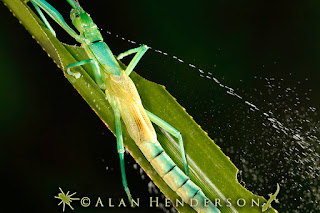This small katydid nymph turned up in our yard earlier this month. It was on a plant frequented by Black rattle ants (Polyrhachis australis) which are about the same size as the nymph.
Not only does the nymph resemble the ants at a glance, its movements were very ant-like. Katydid specialist David Rentz thinks the nymph may be Kurandoptera purpura.
Wednesday, October 31, 2012
Wednesday, October 17, 2012
Peppermint twist
Megacrania batesii is known as the Peppermint stick insect for a very good reason. As a defence it sprays a dual-streamed blast of peppermint scented liquid at its predators. The defensive chemical is produced by glands in the thorax and liquid is stored in sacs which lead to ducts just behind the insect's head.
 |
| Megacrania batesii discharging the defensive chemical from ducts just behind the head. |
 |
| The entire exuvia with the two white sacs present at the left near the head. |
 |
| The sacs can be clearly seen filled with the white peppermint scented chemical. If you are interested in keeping these or other fascinating stick and leaf insects visit Minibeast Wildlife's site. |
Subscribe to:
Comments (Atom)

